 NASA begins making detailed plans for a pair of orbiter/lander spacecraft, now named Viking, to be sent to Mars in the mid 1970s (possibly as early as 1973). With more recent Mariner missions having revealed a number of major challenges, including a thin atmosphere which won’t significantly slow a heavy object such as a landing vehicle, mission planners have to consider entirely new methods of reentry (as opposed to the Earthlike atmosphere that was expected as recently as 1964). The twin Viking spacecraft will not lift off until 1975.
NASA begins making detailed plans for a pair of orbiter/lander spacecraft, now named Viking, to be sent to Mars in the mid 1970s (possibly as early as 1973). With more recent Mariner missions having revealed a number of major challenges, including a thin atmosphere which won’t significantly slow a heavy object such as a landing vehicle, mission planners have to consider entirely new methods of reentry (as opposed to the Earthlike atmosphere that was expected as recently as 1964). The twin Viking spacecraft will not lift off until 1975.

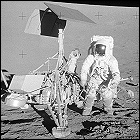 Astronauts Pete Conrad and Alan Bean land on the moon in the Apollo 12 lunar module Intrepid, a mere 600 feet away from the 1967 landing site of the unmanned Surveyor 3 probe. Pieces of Surveyor 3 are gathered for return to Earth to study the effects of prolonged exposure to the lunar environment. Conrad and Bean conduct two moonwalks, each lasting nearly four hours.
Astronauts Pete Conrad and Alan Bean land on the moon in the Apollo 12 lunar module Intrepid, a mere 600 feet away from the 1967 landing site of the unmanned Surveyor 3 probe. Pieces of Surveyor 3 are gathered for return to Earth to study the effects of prolonged exposure to the lunar environment. Conrad and Bean conduct two moonwalks, each lasting nearly four hours. NASA and ESSA launch the ITOS satellite, also known as TIROS-M, a next-generation weather satellite intended to take over from the constellation of short-lived ESSA weather satellites. With a configuration that is, for the first time, significantly different from the TIROS/ESSA satellites, the TIROS-M design’s shakedown cruise is a short and bumpy one: after system failures force a shutdown of the satellite’s attitude control system, it is shut down in mid-
NASA and ESSA launch the ITOS satellite, also known as TIROS-M, a next-generation weather satellite intended to take over from the constellation of short-lived ESSA weather satellites. With a configuration that is, for the first time, significantly different from the TIROS/ESSA satellites, the TIROS-M design’s shakedown cruise is a short and bumpy one: after system failures force a shutdown of the satellite’s attitude control system, it is shut down in mid-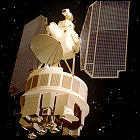 NASA launches the Nimbus 4 satellite, designed to observe weather patterns from orbit and test new weather and climate detection technologies. Nimbus 4 is among the first satellites to test what will become known as global positioning system technology, capable of pinpointing ground-based targets with special equipment. The satellite begins to experience intermittent attitude control problems in
NASA launches the Nimbus 4 satellite, designed to observe weather patterns from orbit and test new weather and climate detection technologies. Nimbus 4 is among the first satellites to test what will become known as global positioning system technology, capable of pinpointing ground-based targets with special equipment. The satellite begins to experience intermittent attitude control problems in 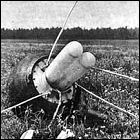 The Soviet Union launches unmanned space probe Luna 16 toward the moon, the first success in the Soviet space program’s ongoing attempt to mount a robotic sample return mission. The lander’s drill-equipped sample collection arm gathers a 35 millimeter, 100-gram core sample of lunar soil, which is then packed into a shielded return capsule for direct return to Earth (seen here after landing). Now claiming that they advocate robotic sample return missions without putting human lives at risk, the Soviets can at last claim a lunar first – the first robotic return to Earth of a soil sample from another body in the solar system.
The Soviet Union launches unmanned space probe Luna 16 toward the moon, the first success in the Soviet space program’s ongoing attempt to mount a robotic sample return mission. The lander’s drill-equipped sample collection arm gathers a 35 millimeter, 100-gram core sample of lunar soil, which is then packed into a shielded return capsule for direct return to Earth (seen here after landing). Now claiming that they advocate robotic sample return missions without putting human lives at risk, the Soviets can at last claim a lunar first – the first robotic return to Earth of a soil sample from another body in the solar system.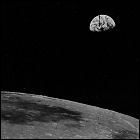 The Soviet Union launches Zond 8, the final Zond flight and the final flight of the Soyuz 7K-L1 capsule which was intended to be the command & service module of the Soviet manned lunar effort. Again, the vehicle orbits the moon and returns to Earth unmanned after a week in space. For only the second time, the 7K-L1 vehicle performs every phase of the flight flawlessly – though the Soviet Union, trying to downplay the space race, now retroactively denies that it was ever interested in sending men to the moon.
The Soviet Union launches Zond 8, the final Zond flight and the final flight of the Soyuz 7K-L1 capsule which was intended to be the command & service module of the Soviet manned lunar effort. Again, the vehicle orbits the moon and returns to Earth unmanned after a week in space. For only the second time, the 7K-L1 vehicle performs every phase of the flight flawlessly – though the Soviet Union, trying to downplay the space race, now retroactively denies that it was ever interested in sending men to the moon. The Soviet Union launches unmanned space probe Luna 17 toward the moon, carrying with it the first automated moon rover, Lunokhod 1. Solar-powered and deployed to the surface via a pair of ramps, the wheeled rover operates for eleven months, more than double the expected operational life span. Unlike Luna 16, Luna 17 and Lunokhod perform their studies of the lunar surface without returning any soil samples to Earth.
The Soviet Union launches unmanned space probe Luna 17 toward the moon, carrying with it the first automated moon rover, Lunokhod 1. Solar-powered and deployed to the surface via a pair of ramps, the wheeled rover operates for eleven months, more than double the expected operational life span. Unlike Luna 16, Luna 17 and Lunokhod perform their studies of the lunar surface without returning any soil samples to Earth.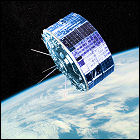 NASA and the newly-rechristened National Oceanic & Atmospheric Administration (formerly ESSA) launch NOAA-1, a weather satellite intended to operate in a near-polar low Earth orbit. Equipped with four cameras, NOAA-1 will operate in orbit for nearly a year before it begins suffering equipment malfunctions. Overheating in the spacecraft’s attitude control system forces ground controllers to turn off some of its weather sensing equipment, and NOAA-1 will eventually be shut down in
NASA and the newly-rechristened National Oceanic & Atmospheric Administration (formerly ESSA) launch NOAA-1, a weather satellite intended to operate in a near-polar low Earth orbit. Equipped with four cameras, NOAA-1 will operate in orbit for nearly a year before it begins suffering equipment malfunctions. Overheating in the spacecraft’s attitude control system forces ground controllers to turn off some of its weather sensing equipment, and NOAA-1 will eventually be shut down in 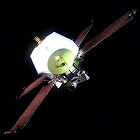 NASA and JPL launch Mariner 8, the first of two identical “Mars ’71” orbiters designed to visit Mars. Where previous missions have simply flown past the red planet, Mariners 8 and 9 are intended to put themselves in orbit and remain there to map the majority of the Martian surface. The second stage of the Atlas-Centaur booster used to launch Mariner 8 fails, however, and the robotic Mars explorer crashes into the Atlantic Ocean. Some of its mission objectives are transferred to the identical Mariner 9, due for launch at the end of the month.
NASA and JPL launch Mariner 8, the first of two identical “Mars ’71” orbiters designed to visit Mars. Where previous missions have simply flown past the red planet, Mariners 8 and 9 are intended to put themselves in orbit and remain there to map the majority of the Martian surface. The second stage of the Atlas-Centaur booster used to launch Mariner 8 fails, however, and the robotic Mars explorer crashes into the Atlantic Ocean. Some of its mission objectives are transferred to the identical Mariner 9, due for launch at the end of the month.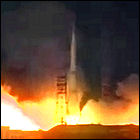 Though the race to the moon has already been lost, the Soviet space program continues to refine its giant N1 rocket, conducting extensive modifications to nearly all of its systems. The third N1 to lift off almost immediately loses directional control, forcing ground controllers to signal it to self-destruct less than a mile off the ground. Its cargo is an unmanned Soyuz/Korabl combo – the Soviet answer to the Apollo command/service module and landing module – though this time there is no launch escape system, so the vehicle is destroyed along with its booster.
Though the race to the moon has already been lost, the Soviet space program continues to refine its giant N1 rocket, conducting extensive modifications to nearly all of its systems. The third N1 to lift off almost immediately loses directional control, forcing ground controllers to signal it to self-destruct less than a mile off the ground. Its cargo is an unmanned Soyuz/Korabl combo – the Soviet answer to the Apollo command/service module and landing module – though this time there is no launch escape system, so the vehicle is destroyed along with its booster.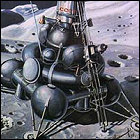 The Soviet Union launches unmanned space probe Luna 18 toward the moon, intended to repeat Luna 16’s feat of gathering and returning a sample of lunar soil to Earth. After spending nearly a week in orbit, Luna 18 descends to the surface, but ground controllers have directed it toward a hazardous mountain region, and contact is lost at the moment the vehicle signals contact with the ground – very likely a sign of a crash landing. No further communication is received from Luna 18, nor is the sample container ever sent back to Earth.
The Soviet Union launches unmanned space probe Luna 18 toward the moon, intended to repeat Luna 16’s feat of gathering and returning a sample of lunar soil to Earth. After spending nearly a week in orbit, Luna 18 descends to the surface, but ground controllers have directed it toward a hazardous mountain region, and contact is lost at the moment the vehicle signals contact with the ground – very likely a sign of a crash landing. No further communication is received from Luna 18, nor is the sample container ever sent back to Earth. The Soviet Union launches unmanned space probe Luna 19 toward the moon, a return to orbital-only missions. Over the course of a year, Luna 19 conducts an extensive mapping campaign of the lunar surface, as well as measuring gravitational anomalies in lunar orbit.
The Soviet Union launches unmanned space probe Luna 19 toward the moon, a return to orbital-only missions. Over the course of a year, Luna 19 conducts an extensive mapping campaign of the lunar surface, as well as measuring gravitational anomalies in lunar orbit.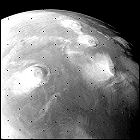 The unmanned NASA/JPL space probe Mariner 9 enters orbit around Mars, becoming the first human spacecraft to orbit another planet in the solar system. The probe begins a nearly year-long survey of the red planet, mapping over 70% of its surface at a much higher resolution than was achieved by the previous NASA Mars probes, Mariners 6 and 7. Mariner 9’s mapping mission is temporarily delayed by a global dust storm obscuring the entire planet when the orbiter arrives. Among its discoveries are Olympus Mons, the solar system’s largest volcano, and the gigantic canyon later named Valles Marineris. Mariner 9 also gathers images of Mars’ two moons, Phobos and Deimos.
The unmanned NASA/JPL space probe Mariner 9 enters orbit around Mars, becoming the first human spacecraft to orbit another planet in the solar system. The probe begins a nearly year-long survey of the red planet, mapping over 70% of its surface at a much higher resolution than was achieved by the previous NASA Mars probes, Mariners 6 and 7. Mariner 9’s mapping mission is temporarily delayed by a global dust storm obscuring the entire planet when the orbiter arrives. Among its discoveries are Olympus Mons, the solar system’s largest volcano, and the gigantic canyon later named Valles Marineris. Mariner 9 also gathers images of Mars’ two moons, Phobos and Deimos.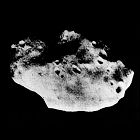 NASA’s Mariner 9 Mars orbiter becomes the first spacecraft to provide relatively close-up images of Mars’ innermost, larger moon, Phobos, from over 3,500 miles away. The irregular shape and heavily cratered surface of Phobos point up its likely origins as an asteroid that long ago came close enough to Mars to be captured into an orbit. Phobos (and its still unseen-at-close-range smaller sibling, Deimos) will be imaged at much closer range later in the 1970s by the Viking orbiters.
NASA’s Mariner 9 Mars orbiter becomes the first spacecraft to provide relatively close-up images of Mars’ innermost, larger moon, Phobos, from over 3,500 miles away. The irregular shape and heavily cratered surface of Phobos point up its likely origins as an asteroid that long ago came close enough to Mars to be captured into an orbit. Phobos (and its still unseen-at-close-range smaller sibling, Deimos) will be imaged at much closer range later in the 1970s by the Viking orbiters. NASA launches Pioneer 10, the first spacecraft sent to study the huge planet Jupiter at close range. Its Atlas-Centaur booster gives it a good head start, propelling it to over 32,000 miles per hour en route to Jupiter, the fastest man-made object in history at this point. Pioneer 10 is also the first man-made vehicle to traverse the asteroid belt, with instruments detecting fewer large particles than anticipated. It will reach Jupiter in late
NASA launches Pioneer 10, the first spacecraft sent to study the huge planet Jupiter at close range. Its Atlas-Centaur booster gives it a good head start, propelling it to over 32,000 miles per hour en route to Jupiter, the fastest man-made object in history at this point. Pioneer 10 is also the first man-made vehicle to traverse the asteroid belt, with instruments detecting fewer large particles than anticipated. It will reach Jupiter in late 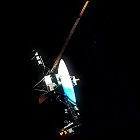 Having spent six years wrangling with various mission profiles for a “Grand Tour” of the outer solar system, made possible by a favorable planetary alignment occurring only once every 175 years, NASA finally authorizes a very stripped-down version of its original ambitious Grand Tour plans. The Mariner Jupiter/Saturn ’77 mission will consist of two twin unmanned spacecraft to be launched in
Having spent six years wrangling with various mission profiles for a “Grand Tour” of the outer solar system, made possible by a favorable planetary alignment occurring only once every 175 years, NASA finally authorizes a very stripped-down version of its original ambitious Grand Tour plans. The Mariner Jupiter/Saturn ’77 mission will consist of two twin unmanned spacecraft to be launched in 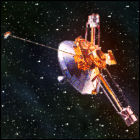 En route to becoming the first human-made spacecraft to visit Jupiter, NASA’s Pioneer 10 also becomes the first human-made spacecraft to enter the asteroid belt between the orbits of Mars and Jupiter. Whether or not the spacecraft will survive this crossing is indeed one of the mission’s major experiments, and is a topic of active debate between scientists with differing views of how densely populated the asteroid belt may be. The spacecraft will survive the crossing without incident.
En route to becoming the first human-made spacecraft to visit Jupiter, NASA’s Pioneer 10 also becomes the first human-made spacecraft to enter the asteroid belt between the orbits of Mars and Jupiter. Whether or not the spacecraft will survive this crossing is indeed one of the mission’s major experiments, and is a topic of active debate between scientists with differing views of how densely populated the asteroid belt may be. The spacecraft will survive the crossing without incident. Originally named ERTS-1 (Earth Resource Technology Satellite), NASA’s Landsat satellite, based on the Nimbus weather satellites, is launched to begin constant observations of Earth’s land, air and oceans. Landsat 1’s tour of duty lasts just under six years, during which it discovers a previously unknown island – never before spotted from land or sea – off the northeastern Canadian coast. Landsat 1 remains in service through
Originally named ERTS-1 (Earth Resource Technology Satellite), NASA’s Landsat satellite, based on the Nimbus weather satellites, is launched to begin constant observations of Earth’s land, air and oceans. Landsat 1’s tour of duty lasts just under six years, during which it discovers a previously unknown island – never before spotted from land or sea – off the northeastern Canadian coast. Landsat 1 remains in service through 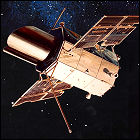 NASA launches the third and final Orbiting Astronomical Observatory satellite, given the nickname “Copernicus” when it successfully enters service near the 500th anniversary of the birth of the famed astronomer of the same name. OAO-3 is a joint venture between NASA and universities in the U.S. and the U.K., again focusing largely on ultraviolet observation of the sky, and it is instrumental in the discovery and study of long-period pulsars. OAO-3 will remain in service through February 1981, its successful nine-year mission lending weight to the ongoing construction and planning of NASA’s Space Telescope project, later to be known as the Hubble Space Telescope.
NASA launches the third and final Orbiting Astronomical Observatory satellite, given the nickname “Copernicus” when it successfully enters service near the 500th anniversary of the birth of the famed astronomer of the same name. OAO-3 is a joint venture between NASA and universities in the U.S. and the U.K., again focusing largely on ultraviolet observation of the sky, and it is instrumental in the discovery and study of long-period pulsars. OAO-3 will remain in service through February 1981, its successful nine-year mission lending weight to the ongoing construction and planning of NASA’s Space Telescope project, later to be known as the Hubble Space Telescope.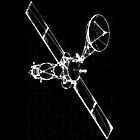 A working group of scientists and engineers at NASA submit an official proposal for a spacecraft using synthetic aperture radar to map the surface of the planet Venus. Conceived as a mission that could be launched from a Titan IIIe or from the space shuttle, both of which still exist only on the drawing board, Venus Orbiter Imaging Radar (or VOIR) is designed to offer extensive mapping of Venus at a resolution much better than the coarse resolution of radar signals originating from Earth-based radio astronomy facilities such as Arecibo, along with such cutting-edge technologies as stereoscopic imaging and solar electric propulsion. Work on this mission will continue through the early 1980s, at which point it is cancelled by NASA and replaced by a cheaper mission intended to achieve the same goals, Magellan.
A working group of scientists and engineers at NASA submit an official proposal for a spacecraft using synthetic aperture radar to map the surface of the planet Venus. Conceived as a mission that could be launched from a Titan IIIe or from the space shuttle, both of which still exist only on the drawing board, Venus Orbiter Imaging Radar (or VOIR) is designed to offer extensive mapping of Venus at a resolution much better than the coarse resolution of radar signals originating from Earth-based radio astronomy facilities such as Arecibo, along with such cutting-edge technologies as stereoscopic imaging and solar electric propulsion. Work on this mission will continue through the early 1980s, at which point it is cancelled by NASA and replaced by a cheaper mission intended to achieve the same goals, Magellan. NASA launches Explorer 48, renamed Small Astronomy Satellite B, from an Italian-owned offshore launch platform off the coast of Kenya. SAS-B is a smaller spacecraft than NASA’s larger Orbiting Astronomical Observatory (OAO) series, but can be aimed very precisely at any gamma ray sources that it detects. One of those sources turns out to be the pulsar remnant of a massive supernova, a discovery later named Geminga. An electrical fault will end SAS-B’s functionality in
NASA launches Explorer 48, renamed Small Astronomy Satellite B, from an Italian-owned offshore launch platform off the coast of Kenya. SAS-B is a smaller spacecraft than NASA’s larger Orbiting Astronomical Observatory (OAO) series, but can be aimed very precisely at any gamma ray sources that it detects. One of those sources turns out to be the pulsar remnant of a massive supernova, a discovery later named Geminga. An electrical fault will end SAS-B’s functionality in 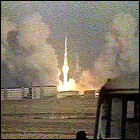 The Soviet space program, still determined to reach the moon, again loads an unmanned Soyuz/Korabl capsule and lander combo onto the huge N1 rocket for another test launch. At an altitude of nearly 25 miles, the N1 experiences severe structural stresses and disintegrates in mid-air, effectively ending the Soviet drive for the moon. Another N1 is prepared for another launch, with an eye toward orbiting a massive space station with which to upstage the upcoming American Skylab station, only to be dismantled on the ground in favor of more reliable launch vehicles.
The Soviet space program, still determined to reach the moon, again loads an unmanned Soyuz/Korabl capsule and lander combo onto the huge N1 rocket for another test launch. At an altitude of nearly 25 miles, the N1 experiences severe structural stresses and disintegrates in mid-air, effectively ending the Soviet drive for the moon. Another N1 is prepared for another launch, with an eye toward orbiting a massive space station with which to upstage the upcoming American Skylab station, only to be dismantled on the ground in favor of more reliable launch vehicles.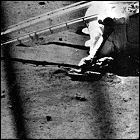 The Soviet Union launches unmanned space probe Luna 21 toward the moon, carrying the Lunokhod 2 robotic rover. Like Lunokhod 1, this rover is solar-powered and can operate independently of its lander, though ground controllers push this vehicle further. Five months into its mission, Lunokhod is driven into a crater from which it is unable to escape; the mission is declared over a month later. This mission is not intended to return lunar soil samples to Earth.
The Soviet Union launches unmanned space probe Luna 21 toward the moon, carrying the Lunokhod 2 robotic rover. Like Lunokhod 1, this rover is solar-powered and can operate independently of its lander, though ground controllers push this vehicle further. Five months into its mission, Lunokhod is driven into a crater from which it is unable to escape; the mission is declared over a month later. This mission is not intended to return lunar soil samples to Earth.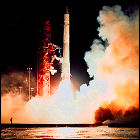 The unmanned space probe Pioneer 11 is launched on a course that will be one of the first real tests of the
The unmanned space probe Pioneer 11 is launched on a course that will be one of the first real tests of the 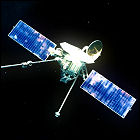 The first unmanned space probe to use a gravity assist maneuver to get from one planet to another in a reduced amount of time, Mariner 10 is lauched on a course for the planet Venus, where a carefully planned trajectory allows it to take pictures and measurements at that planet before using Venus’ gravity to fling Mariner 10 inward toward Mercury, allowing it to reach two planets in under two months. It will be the first space probe to visit Mercury.
The first unmanned space probe to use a gravity assist maneuver to get from one planet to another in a reduced amount of time, Mariner 10 is lauched on a course for the planet Venus, where a carefully planned trajectory allows it to take pictures and measurements at that planet before using Venus’ gravity to fling Mariner 10 inward toward Mercury, allowing it to reach two planets in under two months. It will be the first space probe to visit Mercury.